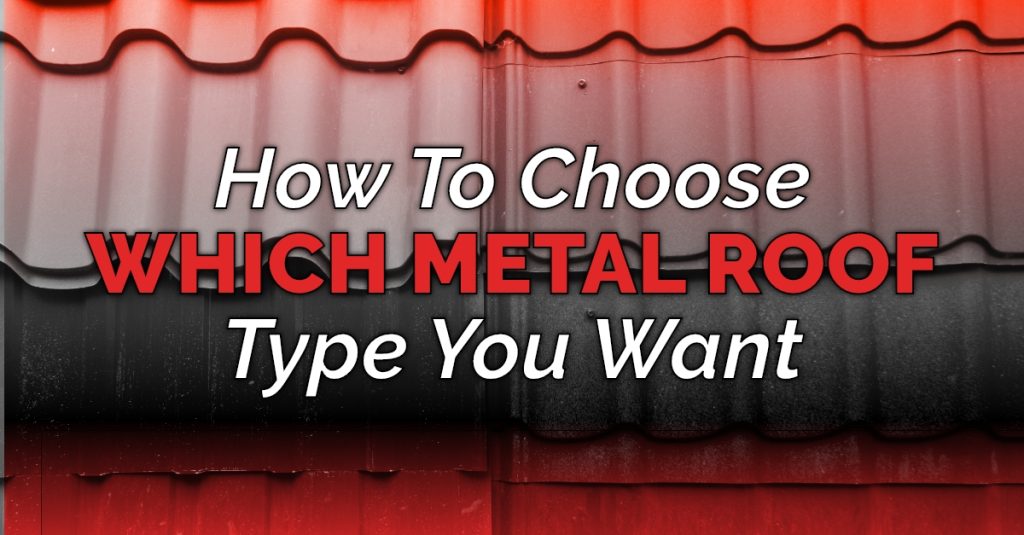Metal roofs have been rising in popularity and have an excellent reputation for being durable, long-lasting, and trendy. Before deciding if a metal roof is right for your home, it’s essential to understand the different types of metal roofs.
While we don’t install metal when we replace roofs, our goal is to provide you with honest information about them to help you make an informed decision.
Below, you’ll find the answers to:
- What are the different types of metal roofs?
- What are the drawbacks of metal roofs?
- Are metal roofs more leak-prone than traditional roofs?
What are the different types of metal roofs?
It’s important to know there are two types of metal roofs – standing seam and exposed fastener. Your experience will vary dramatically based on which one you choose.
Standing seam metal roofs are the gold standard in roofing. They are commercial grade and have an interlocking design with no exposed screws – drastically decreasing any chance of a leak. Of course, the high quality and durability of a standing seam metal roof comes with a hefty price tag. Starting prices for standing seam metal roofs can be as much as four times the cost of traditional asphalt shingles. Due to their significant investment, residential homeowners rarely choose this option.
The second most common type of metal roofing is called exposed fastener. This system involves metal panels that are nailed to the roof in a similar fashion to shingles. It’s called an exposed fastener metal roof because the fasteners which affix the metal panel to the deck or framing are visible or ‘exposed.’ It can provide a homeowner the trendy metal roof appearance at a fraction of the cost of a standing seam roof. However, the exposure of the fastener head can cause major problems for your roof.
Consider These 3 Things Before Choosing A Metal Roof
1. Installation/Customization
Exposed fastener: Metal panels used in exposed fastener roofing can make it extremely difficult to fit roofing fixtures. This includes chimneys, eaves, and any round object on your roof. Metal panels are modified on-site to accommodate penetrations, and homeowners are at the mercy of their roofing contractor’s sheet metal skills. Metal panel trims and closures can be challenging to fabricate – especially around non-square areas. The installation difficulty also increases your installation cost. Eaves and non-square penetrations on your roof pose a massive risk with an exposed fastener roof, as any gap in the panels create more potential for leaks. It is important to remember that an experienced roofer’s skills don’t necessarily translate into sheet metal fabrication skills. A metal roof should be installed by a highly skilled sheet metal fabricator who can properly address wall flashings, chimneys, penetrations, skylights, valleys, or anything else that raises the degree of difficulty.
Standing seam: Standing seam roofs are made from large panels with an interlocking design. They are custom-fitted for your home or business. Leaks in standing-seam roofs are extremely rare.
2. Durability
Exposed fastener: Exposed fastener roofs (in our experience) are not as durable when compared to standing seam or traditional asphalt shingles. This is due to the many opportunities the system has to produce leaks.
There are thousands of fasteners (holes) in the metal panels, and the rubber gasket on the fastener is all that is preventing leaks. Over time, the metal panels will expand and contract with heat and weather. The screws in the metal panel prevent this movement – also called ‘floating.’ Due to the inability of the metal panel to float, this creates a gap between the rubber gasket around the screw and the metal panel – which gets bigger every year! These gaps create thousands of potential points in your roof where a leak could occur.
Standing seam: This roof is exceptionally durable. The interlocking, custom-fitted design makes it extremely difficult for any elements to penetrate your roof. Standing seam metal roofs can last thirty years, and given the right conditions, fifty years isn’t out of the question.
3. Cost
Exposed fastener: Exposed fastener and traditional asphalt roofing are comparable in cost. Exposed fastener roofing might be slightly more expensive depending on the panel you chose and if your roofing contractor charges a premium for fabricating around special case areas on your roof. Another critical factor to consider is long-term cost. Exposed fastener screws have a horrible reputation for leaking – costing you in repairs, early replacement, and more.
Standing seam: Standing seam metal roofs are typically cost-prohibitive for residential homeowners. Standing seam roofs can cost as much as four times the amount of a traditional asphalt roof. This is one reason standing-seam roofs are more frequently seen in commercial settings.
Wrapping Up
Careful consideration should be given to the material selection of your roof. It’s also essential to hire a roofing contractor you trust. Not sure how to hire a roofing contractor?
AIC Roofing is a top-rated roofing company locally owned and operated in Lexington, Kentucky. We have over 20 years of experience and handle inspections, repairs, and replacements. If you’re interested in receiving a free estimate on your shingle roof replacement, contact us today!
Default insurance Lexington Louisville Richmond roof replacement
